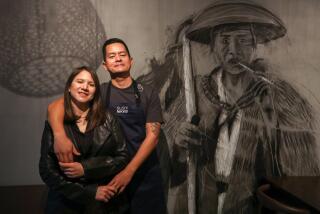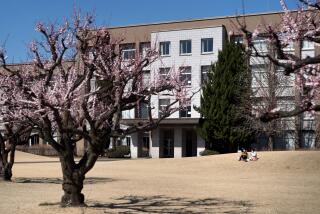All Hail Salem Teikyo University: <i> Moshi</i> -<i> Moshi</i> Meets West Virginia : East-West: The Japanese purchase a stake in U.S. higher education. A half-Japanese, half-American student body merges in the Mountain State.
- Share via
SALEM, W.V. — The circular announces a seminar at the local college, not the topic you might expect for what appears to be a typical Appalachian mountain hamlet: “Japanese and Americans: Likes/Dislikes, Values, Customs, Differences.”
Ever since last July, when Salem College announced a merger with Japan’s Teikyo University, things unexpected have become the norm. Now, the town (population 2,200), along with the renamed Salem Teikyo University, prepares for the April arrival of its first wave of Japanese matriculants.
The school currently has only 400 students, so enrollment of about 200 Japanese will have a substantial, immediate impact. More important, unlike a typical study-abroad program, Salem and Teikyo have become as one.
On the surface, the deal was a desperately needed financial shot in the arm for Salem, having been in a decades-long struggle for survival. The college, with no endowment, was “traditionally the poorest private college in West Virginia and all of Appalachia,” said Dr. Ronald Ohl, who headed the old school and is now president of Salem Teikyo University.
The Japanese university will eventually pump $20 million into Salem Teikyo, enabling the school to pay off its debts, with enough left over for a healthy $7.5 million endowment. If all goes according to plan, the reconstituted university will have a 1995 student body of 1,000, half American, half Japanese.
For Teikyo, a relatively new (1966) Tokyo-based university, the merger is part of an ambitious plan to develop relationships with a number of foreign universities. In the United States, Iowa-based Westmar College was “reorganized, not merged” in early March to become Teikyo Westmar University. And in Denver, Teikyo purchased one of Regis College’s seven campuses for a reported $7 million--it has been renamed as Teikyo Loretto Heights--to begin a joint program in Pacific studies. Both colleges will welcome several hundred Japanese students this spring.
Teikyo’s role at Salem, however, is far deeper. Teikyo University Foundation has taken title to the college’s physical assets; the board of trustees now numbers three Japanese and two Americans.
The architect of these programs is Teikyo University President Shoichi Okinaga, an aggressive proponent of kokusai , the movement for internationalizing the Japanese higher-educational system, begun about 15 year ago.
One of the main goals is to establish a presence in the United States. Okinaga began the process about two years ago, contacting about 30 U.S. colleges and universities. Salem immediately expressed interest. Okinaga cited the main attractions of West Virginia: a low crime rate, “the warmth of its people” and a surfeit of available space.
Space is important, say Japanese educational experts. Private universities in Japan, especially those in Tokyo, are hamstrung by lack of room to build new classrooms and libraries.
There is also the delicate matter of how much profit Teikyo expects from its U.S. ventures. Gail Chambers, a University of Rochester researcher currently studying U.S.-Japanese educational operations, says “the economic motive is present” in every case she has examined.
Whatever Teikyo’s motives, a number of influential U.S. figures, including Sen. Jay Rockefeller (D-W.V.), are more than pleased. Rockefeller, who studied in Japan and speaks some Japanese, promoted Salem’s advantages to the Teikyo representatives as the deal was being negotiated. He has credited Okinaga with “furthering international understanding through educational opportunity.” Rockefeller, West Virginia Gov. Gaston Caperton and Okinaga will receive honorary degrees from the university at commencement exercises this spring.
At the same time, as is the case with most high-profile Japanese investments, some Americans are suspicious--of the merger and of Teikyo’s intentions. Clyde V. Prestowitz Jr., a former U.S. trade official and author of the book “Trading Places: How We Allowed Japan to Take the Lead,” said that while he agrees that educational exchanges have value, “you don’t have to buy a college to send students abroad.” An aide to Sen. John H. Heinz III (R-Pa.), who has also been critical of the U.S. trade relationship with Japan, said the merger “is significant in a symbolic sense, like the purchase of Rockefeller Center.”
But President Ohl, who once studied philosophy under Reinhold Niebhur and Paul Tillich, sees experiments like Salem as the antidote for such skepticism. “The only way you’re going to counter fear, in either country, is by learning to work with each other,” he said.
To ensure as much cultural integration as possible, all students will have to share common dormitories, although incoming Japanese will be sectioned-off during an initial semester of intensive English instruction.
Next month, Salem Teikyo will embark on a three-semester system, characteristic of Japanese universities. The school will also introduce a modular program--students focused exclusively on one subject area for three weeks at a time. “The curriculum is designed to break down barriers that usually exist in study-abroad programs,” Ohl said.
Emi Hirano, one of a handful of Japanese already on campus, said her incoming classmates might be in for a bit of shock. “I couldn’t believe it, this place is nothing but hills,” said Hirano, a freshman. The school’s equestrian program, of all things, was what won her affection. “In Tokyo,” she said, “it is too expensive to own a horse.”
What encourages Ohl is how well Hirano and the other Japanese students seem to be getting along with the Americans. “One of the Japanese girls even has an American boyfriend,” he said, somewhat proudly. But Hirano knows that the social dynamics could quickly change when the first large contingent of students begins to arrive from Japan. “I hope the U.S. kids don’t become afraid,” she said.
Ohl said he anticipated some student resentment, in part because academic standards have stiffened. The average SAT score at Salem is an undistinguished 700; the goal is to raise that as much as 400 points over the next four years.
“Unfortunately,” Ohl acknowledged, “many of those already here will not feel comfortable with the new standards, or with the increasing internationalization. That should change with future classes.”
In town, the joke making the rounds a few months ago had to do with the way one pronounces Teikyo--”as in take-you,” said one Salem wag. Mayor Donna Stewart has worked hard, asking people to be patient: “The biggest fear I have is that people will not take the time to understand people who don’t speak English well.” Expectations that the coming of the Japanese will trigger a boom in the local real-estate market have not yet materialized; informed sources report more talk than sales activity.
In fact, townspeople seem less concerned than some Washington pundits. Retiree Harry Oberstadt, who fought in the South Pacific in World War II, asked, “We’re sending our kids over there and everywhere else, so why shouldn’t they come here?”
More to Read
Sign up for Essential California
The most important California stories and recommendations in your inbox every morning.
You may occasionally receive promotional content from the Los Angeles Times.













